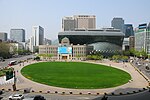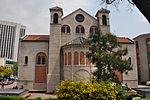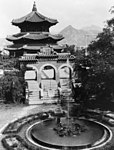Seoul City Hall
Buildings and structures in SeoulGovernment of SeoulImperial Crown Style architectureJung District, SeoulSeats of local government ... and 1 more
South Korean building and structure stubs

Seoul City Hall is a governmental building for the Seoul Metropolitan Government in South Korea, in charge of the administrative affairs of Seoul. It is located in Taepyeongno, Jung-gu, at the heart of Seoul. It is connected to City Hall Station (Seoul) on Seoul Subway Line 1, with access to Seoul Subway Line 2 from the same station. In front of the current city hall is the old city hall building, now Seoul Metropolitan Library, and Seoul Plaza (Korean: 서울광장).
Excerpt from the Wikipedia article Seoul City Hall (License: CC BY-SA 3.0, Authors, Images).Seoul City Hall
Sejong-daero, Seoul Myeong-dong
Geographical coordinates (GPS) Address Nearby Places Show on map
Geographical coordinates (GPS)
| Latitude | Longitude |
|---|---|
| N 37.566405555556 ° | E 126.97782222222 ° |
Address
서울도서관
Sejong-daero 110
04524 Seoul, Myeong-dong
South Korea
Open on Google Maps







